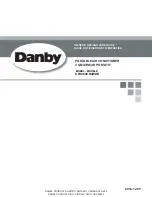
II.
MAINTENANCE
WARNING:
Disconnect electrical power to all circuits
before servicing unit. Failure to do so may result in
personal injury from electrical shock or moving parts.
WARNING:
As with any mechanical equipment, per-
sonal injury can result from sharp metal edges. Be careful
when removing parts.
A.
Return-Air Filter
To clean or replace air filter, remove screws and filter access door.
Slide out filter. For washable type filters, clean with hot soapy
water. Rinse clean and let dry.
New filters are available from a local distributor. Place filter in slot
with filter arrow facing direction of airflow. Replace filter access
doors with screws previously removed.
CAUTION:
Never operate unit without a filter or with
filter access door removed. Damage to blower motor may
result.
B.
Coil, Drain Pan, and Condensate Drain
CAUTION:
Disconnect electrical power before remov-
ing any access panels or electrical shock may result.
The coil is easily cleaned when dry. To check or clean coil, remove
coil access panel. If coil is coated with dirt or lint, vacuum with a
soft brush attachment.
Be careful not to bend fins. If coil is coated with oil or grease, it
may be cleaned with mild detergent and water solution. Rinse coil
with clean water. Be careful not to splash water on insulation or
filter.
Check drain pan and condensate drain at same time cooling coil is
checked. Clean drain pan and condensate drain by removing any
foreign matter from pan. Check for rust and holes. Flush pan and
drain tube with clear water. If drain is restricted, clean with
high-pressure water. If this does not work, use a plumber’s snake
or similar probe device. Repitch drain pan to promote proper
drainage.
FA4A, FB4A, FC4B, AND FX4A SMART HEAT
CIRCUIT BOARD FUNCTION AND TROUBLESHOOTING
I.
PCB COMPONENT LAYOUT, DESCRIPTION,
AND FUNCTION
NOTE:
All voltages are AC unless otherwise specified.
1. The low-voltage terminal board is used to connect indoor
thermostat to low, 24-v side of transformer and to serve as
a junction between indoor thermostat and outdoor section.
a. R terminal is used to connect secondary side of trans-
former to thermostat and outdoor unit. R is fused.
b. C terminal is used to connect transformer secondary
common for thermostat and outdoor unit.
c. Y terminal provides input signal from thermostat signal-
ing heat pump operation.
d. G terminal provides input signal from thermostat signal-
ing continuous fan operation.
e. O terminal provides input and junction terminal for
reversing valve signal.
f. W2D terminal provides input from outdoor unit (heat
pump) signaling control board that heat pump is in
defrost.
g. W2T terminal provides input from thermostat signaling
for supplemental or emergency heat.
h. W3 terminal provides input from outdoor thermostat.
W3 and W2T are factory connected by JW1. This input
is used only if an outdoor thermostat is required by local
codes.
i. Y
o
terminal provides output from control board to
energize outdoor unit (heat pump) contactor.
2. Jumper wires (JW1 and JW2). (See Fig. 39.)
a. JW1 connects W2T to W3 to limit staging of electric
heat with use of an outdoor thermostat. See Table 10 for
staging. Smart Heat PCB controls staging to the extent
that this feature is unnecessary unless required by local
codes or regulations.
b. Cutting JW2 sets Smart Heat PCB in efficiency mode.
With JW2 cut, there is no loss of performance due to
reduced indoor blower speed when heat pump is oper-
ating near balance point. This jumper may need to be cut
if selected cooling fan speed is the same as required
minimum motor LO speed tap selection. With JW2 cut,
fan terminal LO becomes a dummy terminal.
3. A fuse is used to protect low-voltage transformer and PCB.
4. AUX+ and AUX- are connections for air conditioning
accessories (EAC, humidifier, etc.).
5. F1, F2, HI, and LO are connections for indoor fan.
6. The 9-pin receptacle connects heater package wiring har-
ness.
7. SEC1 and SEC2 are used to connect secondary side of
transformer to PCB. SEC1 is internally connected to equip-
ment ground.
II.
UNIT FUNCTIONS
A.
Transformer
NOTE:
Terminals T1, T2 (if used), and T3 are wired to primary
or high side of transformer. The 208-v terminal (or blue wire if
transformer has primary leads) is used on T3 for 208-v applica-
tions. The 230-v terminal (or red wire) is used on T3 for 230-v
applications. T2 is a dummy terminal.
B.
Electric Heat
NOTE:
When troubleshooting elements, position thermostat to
emergency heat. Wait approximately 12 minutes after all thermo-
stat delays for all elements to come on.
1. When thermostat calls for supplementary heat, a 24-v signal
is sent to PCB through W2T. The PCB energizes first stage
of electric heat.
2. The first 2 stages come on if W2T and Y are energized at
the same time. After each 10 minutes W2T is energized,
another stage of electric heat is energized.
3. As W2T is de-energized, electric heat stages down in 8
minute steps with the exception of first step. The first step
will be on only half as long as it was prior to W2T
de-energizing.
4. When W2T is energized by itself, JW1 is cut, and an
outdoor thermostat is used and is open, staging is limited as
in Table 10.
5. When both W3 and W2T are energized without JW1 being
cut or with outdoor thermostat closed, system operation
stages heat up to maximum level if signal is energized for
proper amount of time.
—46—







































